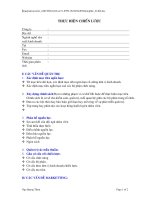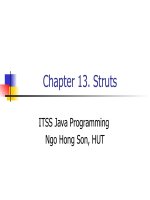C1395 c13
Bạn đang xem bản rút gọn của tài liệu. Xem và tải ngay bản đầy đủ của tài liệu tại đây (23.87 KB, 2 trang )
Designation: C 1395 / C 1395M – 98
AMERICAN SOCIETY FOR TESTING AND MATERIALS
100 Barr Harbor Dr., West Conshohocken, PA 19428
Reprinted from the Annual Book of ASTM Standards. Copyright ASTM
Specification for
Gypsum Ceiling Board1
This standard is issued under the fixed designation C 1395 / C 1395M; the number immediately following the designation indicates the
year of original adoption or, in the case of revision, the year of last revision. A number in parentheses indicates the year of last
reapproval. A superscript epsilon (e) indicates an editorial change since the last revision or reapproval.
cation that provides not less than 3⁄4 h fire–resistance for boards
applied parallel with and on each side of load bearing 2 3 4
wood studs spaced 16 in. [406 mm] on centers with 6d coated
nails, 17⁄8 in. [48 mm] long, 0.0915 in. [2.3 mm] diameter
shank, 1⁄4 in. [6.4 mm] diameter heads, spaced 7 in. [178 mm]
on centers with gypsum board joints staggered 16 in. [406 mm]
on each side of the partition and tested in accordance with Test
Methods E 119.
1. Scope
1.1 This specification covers 1⁄2 in. [12.7 mm] thick gypsum
ceiling board designed for use on interior ceilings with framing
spaced not more than 24 in. [610 mm] on center and that
affords a surface suitable to receive water–based texture and
other decoration. This product is also suitable for use on
interior walls.
1.2 The values stated in either inch–pound units or SI
(metric) are to be regarded separately as standard. Within the
text, the SI units are shown in brackets. The values stated in
each system shall be used independent of the other. Values
from the two systems shall not be combined.
NOTE 1—Consult producers for independent test data on assembly
details and fire resistance classifications for other types of construction.
See official fire test reports for assembly particulars, materials, and
classifications.
4.3 Gypsum ceiling board shall have a flame spread index of
not more than 25 when tested in accordance with Test Method
E 84.
2. Referenced Documents
2.1 ASTM Standards:
C 11 Terminology Relating to Gypsum and Related Building Materials and Systems2
C 473 Test Methods for Physical Testing of Gypsum Panel
Products2
C 645 Specification for Nonstructural Steel Framing Members2
C 1264 Specification for Sampling, Inspection, Rejection,
Certification, Packaging, Marking, Shipping, Handling,
and Storage of Gypsum Board2
E 84 Test Methods for Surface Burning Characteristics of
Building Materials3
E 119 Test Methods for Fire Tests of Building Construction
and Materials3
5. Physical Properties
5.1 Specimens shall be taken from the samples obtained in
accordance with Specification C 1264.
5.1.1 Specimens shall be tested in accordance with Test
Methods C 473.
5.1.2 Flexural Strength—The specimens shall be tested face
up and face down. The average breaking load shall be not less
than that given in Table 1.
5.1.3 Humidified Deflection—The specimens shall have an
average deflection of not more than 5⁄16 in. [8 mm].
5.1.4 Core, End, and Edge Hardness—The specimens shall
have an average hardness of not less than 15 lbf [67 N] when
tested by Method A and 11 lbf [49 N] when tested by Method
B.
5.1.5 Nail Pull Resistance—The specimens shall have an
average nail–pull resistance of not less 80 lbf [356 N] when
tested by Method A and 77 lbf [343 N] when tested by Method
B.
3. Terminology
3.1 Definitions used in this specification shall be in accordance with Terminology C 11.
4. Materials and Manufacture
4.1 Gypsum ceiling board shall consist of a noncombustible
core, essentially gypsum, surfaced with paper bonded to the
core.
4.2 Gypsum ceiling board, type X (special fire-resistant),
designates gypsum ceiling board complying with this specifi-
6. Dimensions and Permissible Variations
6.1 Specimens shall be taken from the samples obtained in
accordance with Specification C 1264.
6.2 Thickness, width, length, and end squareness shall be
determined in accordance with Test Methods C 473.
6.2.1 Thickness—The nominal thickness shall be 1⁄2 in.
[12.7 mm] with permissible variations in the nominal thickness
of 61⁄64 in. [0.4 mm] with permissible local variations of 61⁄32
in. [0.8 mm] from the nominal thickness.
6.2.2 Width—The width shall be up to 48 in. [1220 mm]
1
This test method is under the jurisdiction of ASTM C-11 on Gypsum and
Related Building Materials and Systems and is the direct responsibility of
Subcommittee C11.01 on Specifications and Test Methods for Gypsum Products.
Current edition approved July 10, 1998. Published December 1998.
2
Annual Book of ASTM Standards, Vol 04.01.
3
Annual Book of ASTM Standards, Vol 04.07.
1
C 1395 / C 1395M
TABLE 1 Flexural Strength
METHOD A
Load, lbf [N]
Load, lbf [N]
Bearing Edges
Bearing Edges
Across Fiber of
Parallel to Fiber of
Surfacing
Surfacing
110 [489]
40 [178]
and either square, recessed, beveled, featured, tapered, or
featured and tapered.
METHOD B
Load, lbf [N]
Load, lbf [N]
Bearing Edges
Bearing Edges
Across Fiber of
Parallel to Fiber of
Surfacing
Surfacing
107 [476]
36 [160]
7. Finish and Appearance
7.1 The surfaces of gypsum ceiling board shall be true and
free from imperfections that would render it unfit for use with
or without decoration.
with a permissible variation of 3⁄32 in. [3 mm] under the
specified width.
6.2.3 Length—The permissible variation in length shall be
6 1⁄4in. [6 mm].
6.2.4 Tapered Edge Depth—The average thickness of the
edge of recessed or tapered edge shall be not less than 0.020 in.
[0.51 mm] but not more than 0.090 in. [2.29 mm] less than the
average thickness of the gypsum ceiling board.
6.2.5 End Squareness—Corners shall be square with a
permissible variation of 6 1⁄8 in. [63 mm] in the full width of
the board.
6.3 Edges and Ends—The edges and ends shall be straight
8. Sampling, Inspection, Rejection, Certification,
Packaging, Marking, Shipping, Handling, and Storage
8.1 Sampling, Inspection, Rejection, Certification, Packaging, Marking, Shipping, Handling, and Storage of gypsum
ceiling board shall be in accordance with Specification C 1264.
9. Keywords
9.1 ceiling; drywall; gypsum; gypsum board; gypsum ceiling board; gypsum wallboard; type X
APPENDIX
(Nonmandatory Information)
This Appendix gives general information and also suggests for inclusions to be made elsewhere by the specifier. It is not part of this
specification.
X1. Alternate Definition for Type X
center along board edges, ends, and along intermediate studs.
Joints shall be oriented parallel to and located over studs and
staggered on opposite sides of the assembly. The face layer 48
in. [1220 mm] wide shall be attached using 1-5⁄8 in. [41 mm]
long drywall screws spaced 12 in. [305 mm] along board
edges, ends, and along intermediate studs. Joints shall be
oriented parallel to and located over studs, offset 24 in. [610
mm] from the base layer joints, and staggered on opposite sides
of the assembly. All joints in the face layer shall be filled with
joint compound, covered with joint tape and covered with an
additional coat of joint compound. All screw heads in the face
layer shall be covered with two coats of joint compound.
X1.1 Gypsum ceiling board, type X (special fire-resistant)
designates gypsum ceiling board providing a greater fire
resistance than regular gypsum ceiling board of the same
thickness. Type X (special fire–resistant) gypsum ceiling
board, when tested in accordance with Test Methods E 119,
shall provide the following minimum fire resistance ratings for
the assembly described.
X1.1.1 2-h for a 1⁄2 in. [12.7 mm] thickness applied to a
partition in a double layer application an each side of 2-1⁄2 in.
[64 mm] deep non–loadbearing galvanized steel studs complying with Specification C 645 spaced 24 in. [610 mm] on center.
The base layer 48 in. [1220 mm] wide shall be attached using
1 in. [25 mm] long drywall screws spaced 12 in. [305 mm] on
The American Society for Testing and Materials takes no position respecting the validity of any patent rights asserted in connection
with any item mentioned in this standard. Users of this standard are expressly advised that determination of the validity of any such
patent rights, and the risk of infringement of such rights, are entirely their own responsibility.
This standard is subject to revision at any time by the responsible technical committee and must be reviewed every five years and
if not revised, either reapproved or withdrawn. Your comments are invited either for revision of this standard or for additional standards
and should be addressed to ASTM Headquarters. Your comments will receive careful consideration at a meeting of the responsible
technical committee, which you may attend. If you feel that your comments have not received a fair hearing you should make your
views known to the ASTM Committee on Standards, 100 Barr Harbor Drive, West Conshohocken, PA 19428.
2









